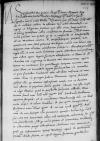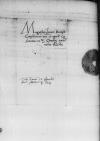Veniens huc ⌊frater⌋ tuus ⌊⌋ nobis abs te reddidit, quibus tu officium tuum nobis commendasti, ea copiose et diligenter scribens, quae istic circa ⌊imperatorem⌋ et ⌊summum pontificem⌋ acta constitutave fuerunt. Illud tamen nobis probari non potuit, quod te a recipiendo et transmittendo ad nos monitorio contra dominum ⌊archiepiscopum Gnesnensem⌋ non excusaveris, cum satis potueris intelligere nobis non debere esse integrum tam odiosum ministerium suscipere adversus primatem ⌊Regni⌋ nostri et eum certe hominem, quem offendere non possemus, quin eadem opera ⌊regem Ioannem⌋ offendamus et illum ob id adversum nos regnumque et dominia nostra commoveamus. Quem tamen ne irritemus, hoc potissimum tempore cavemus, cum inter illum et serenissimum ⌊regem Ferdinandum⌋ de concordia et pace facienda oratorem nostrum ad illum misimus, et cum etiam illum in promptu habere ⌊Turcarum⌋ copias sciamus, quibus ille ex minima offensionis causa nos et dominia nostra adoriri et populari facile posset.
Quare nos ista causa et aliis rationibus, quas in prospectu habemus, adducti, monitorium simul cum litteris nostris reverendissimo domino ⌊cardinali Sanctorum Quattuor⌋ scriptis ad te remittimus mandamusque tibi, ut illud certo aliquo et celeri nuntio dominationi suae reverendissimae transmittas. Scribimus enim ⌊illius reverendissimae dominationi⌋, ut nos apud ⌊sanctissimum dominum nostrum⌋ de non suscepta ista provincia excuset declaretque sanctitati suae nos non temeritate ulla vel contemptu voluntati suae sanctitatis non satisfecisse, sed quod nobis pacem et concordiam tractantibus in alterutrius partis offensionem declinare non conveniat, quod ex insinuatione ipsius monitorii apud dominum ⌊archiepiscopum⌋ primum, deinde statim et apud ⌊regem Ioannem⌋ proculdubio  BCK, 1601, p. 230 incurrissemus. Verum, ne et altera pars queri de nobis ob hoc possit, quod operam nostram in vindicandis ⌊domini archiepiscopi⌋ admissis, de quibus criminatur, ⌊summo pontifici⌋ negaremus, scripsimus domino ⌊cardinali⌋, ut expositis causis excusationis nostrae summo pontifici declaret nos neque defensionem vel accusationem factorum domini archiepiscopi suscipere velle, neque etiam prohibituros esse, ut sanctitas sua per alias quasvis personas, vel nuntium proprium, auctoritatem suam in dominum archiepiscopum exerceat sive punitionem illi, si convictus fuerit, decernat, modo ab istis odiosis ministeriis et quae etiam non sunt cum dignitate, persona nostra sit immunis, quam excusationem tu quoque apud ⌊caesaream maiestatem⌋, ubi opus videbitur, nomine nostro facias.
BCK, 1601, p. 230 incurrissemus. Verum, ne et altera pars queri de nobis ob hoc possit, quod operam nostram in vindicandis ⌊domini archiepiscopi⌋ admissis, de quibus criminatur, ⌊summo pontifici⌋ negaremus, scripsimus domino ⌊cardinali⌋, ut expositis causis excusationis nostrae summo pontifici declaret nos neque defensionem vel accusationem factorum domini archiepiscopi suscipere velle, neque etiam prohibituros esse, ut sanctitas sua per alias quasvis personas, vel nuntium proprium, auctoritatem suam in dominum archiepiscopum exerceat sive punitionem illi, si convictus fuerit, decernat, modo ab istis odiosis ministeriis et quae etiam non sunt cum dignitate, persona nostra sit immunis, quam excusationem tu quoque apud ⌊caesaream maiestatem⌋, ubi opus videbitur, nomine nostro facias.
De tuo ad nos reditu nihil adhuc statuere potuimus, instituto enim ⌊conventu imperii⌋ necessarium nobis visum est, ut nostri et imperialis honoris gratia ⌊caesaream maiestatem⌋ sequaris tamdiuque in eius aula maneas, quamdiu illa erit in ⌊Germania⌋, et tuo loco, siquid adversum nos vel dominum ⌊Prussiae ducem⌋ dici vel agi senseris, strenue et prudenter defendas, sicut et honos noster et tua erga nos fides postulare videbuntur. Non sine enim gravi molestia audimus nomen nostrum apud ⌊caesaream maiestatem⌋ et alios principes iniuste ob hoc traduci, quod scilicet et ⌊regi Ioanni⌋ faveamus et cum ⌊Turcis⌋ vel ⌊Lutheranis⌋ consilia vel conspirationes aliquas hidden by binding⌈[as]as hidden by binding⌉ faciamus, quae res omnes longissime absunt a voluntate et cogitatione nostra. Proinde tibi iterum atque iterum hoc praecipimus, ut diligenter hos rumores de nobis sublatos abolere persuadereque cuivis aliud opinanti cures, nos semper in integritate, constantia et officio Christiani principis mansisse, hactenus manere et perpetuo mansuros esse. Quod vero ad provisionem tuam attinet, curavimus, ut serenissima ⌊coniunx nostra⌋  BCK, 1601, p. 231 mandaret tibi ex proventibus ⌊Ducatus Barensis⌋ numerari omne id, quod ab eo tempore, quo capere annuam tuam vel menstruam provisionem desiisti, ad 1530-05-01⌊primam usque diem Maii1530-05-01⌋ retentum erit. Nos vero, ut deinceps habeas, quo te in ⌊Germania⌋ sustentes, assignari tibi in banco ⌊Focarorum⌋ mandavimus centum aureos, in singulos menses capiendos, hinc vero ducentos aureos ad rationem stipendii equorum tuorum tibi mittimus et alios ducentos, quos te credito recepisse scribis, solvi et numerari mandavimus. Volumus autem, ut nobis saepius scribas pro more tuo de rebus omnibus, quae istic occurrent, pro fide tua et gratia nostra.
BCK, 1601, p. 231 mandaret tibi ex proventibus ⌊Ducatus Barensis⌋ numerari omne id, quod ab eo tempore, quo capere annuam tuam vel menstruam provisionem desiisti, ad 1530-05-01⌊primam usque diem Maii1530-05-01⌋ retentum erit. Nos vero, ut deinceps habeas, quo te in ⌊Germania⌋ sustentes, assignari tibi in banco ⌊Focarorum⌋ mandavimus centum aureos, in singulos menses capiendos, hinc vero ducentos aureos ad rationem stipendii equorum tuorum tibi mittimus et alios ducentos, quos te credito recepisse scribis, solvi et numerari mandavimus. Volumus autem, ut nobis saepius scribas pro more tuo de rebus omnibus, quae istic occurrent, pro fide tua et gratia nostra.
 BCK, 1601, p. 230 incurrissemus. Verum, ne et altera pars queri de nobis ob hoc possit, quod operam nostram in vindicandis
BCK, 1601, p. 230 incurrissemus. Verum, ne et altera pars queri de nobis ob hoc possit, quod operam nostram in vindicandis  BCK, 1601, p. 231 mandaret tibi ex proventibus
BCK, 1601, p. 231 mandaret tibi ex proventibus 


